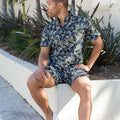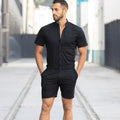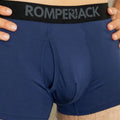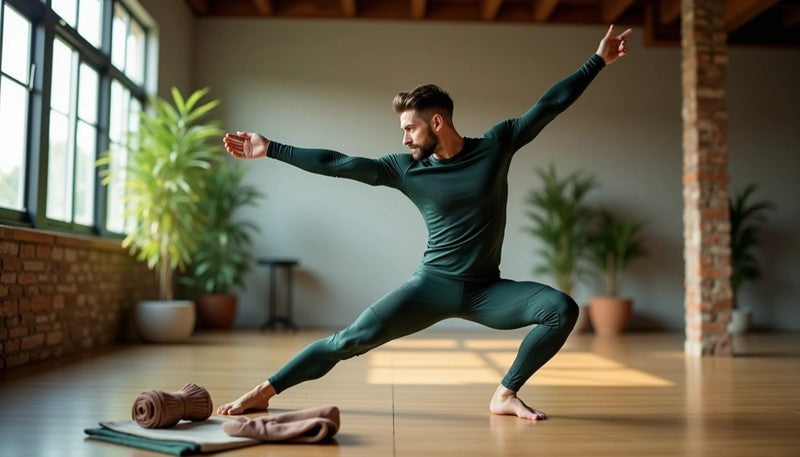The global activewear market shows remarkable growth, with projections reaching $547 billion by 2024 and expanding to $941.65 billion by 2034. Athleisure orders have surged by 84% since the pandemic started, showing a fundamental change in men's approach to athletic wardrobes.
Sustainability now leads this development. The U.S. sports apparel market reached $105.1 billion in 2020, yet modern sportswear focuses on both performance and ethical production. Men's designer sportswear and athletic wear trends in 2025 showcase a green transformation. Brands now use recycled materials from plastic bottles and fishing nets, and they have adopted biodegradable fabrics like organic cotton, hemp, and bamboo.
This movement toward environmentally conscious men's activewear represents more than a trend—it reshapes the scene throughout the fashion world. This piece will take a closer look at sustainable breakthroughs that shape men's activewear, from eco-friendly materials to smart technology integration. Consumer preferences continue to drive this meaningful change toward a greener, healthier future.
The Rise of Eco-Friendly Materials in Activewear
The rise of eco-friendly practices in men's activewear marks a new chapter where state-of-the-art materials blend performance with planet-friendly features. Recent studies show 88% of shoppers want the fashion industry to cut down pollution, and 67% prefer clothes made from eco-friendly materials. This shift in consumer mindset has led brands to rethink the basic building blocks of trendy sportswear.
Recycled polyester and nylon from plastic waste
Recycled polyester serves as the life-blood of eco-friendly athletic wear trends by turning used plastic bottles into high-performance fabrics. This method has cut down CO2 emissions by 1.32 billion kg. Brands that use recycled polyester in their men's designer sportswear lines keep the same moisture-wicking and durability as new materials, yet use substantially less energy to produce.
Recycled nylon brings remarkable benefits to the environment by reusing abandoned fishing nets and fabric scraps. This method saves up to 75% of the energy needed for new nylon and cuts greenhouse gas emissions by up to 80%. The effect on oceans is huge since more than 640,000 tons of fishing nets end up abandoned in oceans each year.
Leading brands like Quince and WINQS SPORTS have accepted new ideas by switching from traditional plastics to materials made from algae fibers and castor beans.
Biodegradable fabrics like bamboo and hemp
Bamboo fabric has become a revolutionary force in men's luxury sportswear thanks to its amazing natural qualities. The fabric stays light, breathes well, fights bacteria, wicks moisture, and blocks UV rays. On top of that, it needs very little water and no pesticides to grow, making it far better for the environment than regular fabrics.
Hemp stands out as another breakthrough material that's gentle on our planet. Nomads Hemp Wear has shown over 20+ years that hemp fabrics last long and feel comfortable while needing minimal water and zero pesticides. Hemp clothes naturally block UV rays and show exceptional strength, which makes them perfect for tough activewear.
These materials shine with impressive eco-friendly features:
· Quick regrowth (bamboo grows back without replanting)
· Almost no chemicals needed for growing
· Carbon capture (bamboo absorbs more CO2 per square inch than trees)
Organic cotton and low-impact alternatives
Organic cotton has altered the map of activewear by removing harmful pesticides and GMOs from production. GOTS certification makes sure these materials meet strict environmental and ethical standards. Athletes worried about sensitive skin find organic cotton a chemical-free option that prevents workout-related irritation.
All the same, brands keep learning about even more state-of-the-art alternatives. Tencel, which comes from well-managed eucalyptus forests, offers amazing softness and breaks down naturally. Brands like Definite Articles have created fully biodegradable activewear that works just like synthetic materials without harming the environment.
Revolutionary ideas come from unexpected places: some makers now create activewear from recycled coffee grounds, leftover farm materials, and even algae. These breakthroughs show how men's designer sportswear redefines the limits of both style and environmental care.
Consumer need for eco-friendly options keeps growing, with 75% of shoppers staying loyal to environmentally conscious brands. These materials aren't just a passing trend—they are the foundations of athletic wear that works for both athletes and the planet.
Smart Tech Meets Sustainability
Technology and sustainability now work together in men's activewear to create a future where smart features improve both performance and environmental responsibility. Trendy sportswear has seen breakthroughs that go way beyond the reach and influence of simple fabric innovation. These smart features bring intelligence and adaptability to eco-friendly garments.
Wearable sensors in eco-conscious fabrics
Smart, Wearable, and Eco-friendly Electronic Textiles (SWEET) represent a breakthrough in athletic wear trends. These sensors blend into sustainable fabrics to monitor vital physiological data while staying environmentally friendly. The technology tracks skin temperature with impressive accuracy (temperature coefficient of resistance value of ~−4.4% °C−1) and monitors heart rate at ~74 beats per minute.
These sustainable smart textiles stand out because they break down naturally. Traditional electronic components create e-waste, but these textiles decompose by about 48% in weight. They lose roughly 98% of their strength in just four months. The graphene-based electrodes used here have a climate change effect of only ~0.037 kg CO2 eq—40 times lower than reference electrodes.
Mens designer sportswear brands can now combine performance tracking with sustainability. These breakthroughs are a great way to get both functionality and environmental responsibility.
Temperature-regulating and self-cleaning textiles
NASA's temperature regulation technology has found its place in sustainable activewear. Natural wax microspheres capture and store body heat. These fabrics work as natural heat buffers and stop overheating before sweat starts. Studies show these materials cut sweat production by up to 48%, whatever the outside temperature.
The 37.5 Technology stands alone in combining natural active particles with better biodegradation and recycled yarn options. Scientific tests prove it boosts athletic performance by up to 26%. This happens because it reduces core temperature buildup during exercise.
Self-cleaning textiles mark another breakthrough in mens luxury sportswear. These fabrics employ nanotechnology at the 1-100 nanometer scale to resist dirt, water, oils, and pathogens. The environmental benefits make a real difference:
· Less water used through fewer washes
· Lower energy needs from reduced laundry
· Less chemical runoff from detergents
· Clothes last longer with fewer washes
Energy-efficient production methods
Sustainable sportswear brands now employ energy-efficient production techniques. Manufacturers utilize wind and solar power throughout their supply chains. Major production countries have widely adopted these methods.
Brands now invest in processes that save water and protect local ecosystems from wastewater. Waste reduction has improved too. Some manufacturers send all fabric scraps to recycling companies that turn them into new sustainable materials, which eliminates production waste.
Green energy in apparel manufacturing has encouraged many breakthroughs in recycling technologies and waste management. Modern energy-efficient machinery replaces old equipment to optimize sustainable production without sacrificing quality.
Sportswear trends show how smart technologies can improve athletic performance while protecting the environment. This creates a win-win situation for consumers and our planet.
Design Trends That Reflect a Greener Future
The esthetic direction of men's activewear has taken a green turn, going beyond just materials and technology. Modern sportswear trends combine environmental responsibility with eye-catching appeal. These pieces excel in both sustainability and style.
Minimalist esthetics with sustainable intent
The minimalist movement in mens designer sportswear goes deeper than visual simplicity. It captures the "less is more" philosophy crucial to environmental stewardship. Neutral colors like black, gray, and white dominate collections. Clean lines and understated tones define this look. These pieces combine smoothly with daily activities and workout sessions, which reduces the need for large wardrobes.
This minimalist approach serves both style and function. Brands like Bold Will follow what they call "Natural Progression." They create simple, timeless designs that build on gradual improvement rather than constant replacement. This approach arranges well with sustainability goals. It emphasizes durable, classic pieces that stay relevant across seasons.
Bold colors and patterns made with natural dyes
The sustainable sportswear world offers more than just neutral colors. Athletic wear trends now feature bright hues and striking patterns created through environmentally responsible methods. Radiant shades like electric blue, fiery red, and neon green make bold statements in and out of the gym.
Natural dyeing processes have become a breakthrough in trendy sportswear. Pangaia uses plant-based dyes that eliminate harmful chemicals common in traditional coloring methods. These natural alternatives reduce environmental effects and feel gentler on skin during sweaty workouts.
Eco-conscious activewear collections now feature geometric designs and abstract motifs. These offer unique visual appeal without the environmental downsides of traditional synthetic dyes.
Versatile pieces like men's rompers and jumpsuits
All-in-one garments mark the most notable change in sustainable men's activewear. Men's rompers and jumpsuits offer the ultimate versatile design. These single pieces eliminate the need to coordinate separate items.
Buddha Pants leads this trend with their 100% cotton yoga jumpsuits. They include practical features like pockets and use plant-based dyes for bold prints. These pieces excel in sustainability through their versatility. Many designs adapt to different styles and pack into their own pockets for easy travel.
Ripple creates comfortable activewear jumpsuits using modal and cotton with non-toxic dyes. These innovative designs reflect growing interest in owning fewer clothes while maximizing function. This shows how sustainability can drive practical breakthroughs in mens luxury sportswear.
The meeting of ethical production and creative design proves that men's activewear can deliver style, function, and environmental responsibility together.
Consumer Demand Driving Ethical Change
The rise of ethical men's activewear comes from a powerful combination of industry changes and aware consumers who just need accountability. Modern shoppers expect brands to align with their values and show real dedication to green practices.
Transparency in sourcing and labor practices
Sportswear trends now demand complete supply chain clarity. The tragic Rana Plaza building collapse killed thousands of garment workers. Rescue teams had to dig through rubble to find clothing labels that would identify the brands manufacturing there. This event showed everyone the dangers of hidden supply chains.
Consumers now know they can't ensure human rights and safe working conditions without tracking where products come from. Many forward-thinking mens designer sportswear brands publish their factory lists openly. This helps them comply with rules like the UK Modern Slavery Act. Anyone can examine their policies and make sure companies stick to their promises.
Certifications like GOTS and Fair Trade
Athletic wear trends now rely heavily on independent certifications. The Global Organic Textile Standard (GOTS) certification will give a clear sign of environmental and ethical standards. Consumers looking for real sustainability trust this mark.
Fair Trade certification focuses on fair wages and worker safety. PACT, to cite an instance, makes clothes in Fair Trade-certified factories in India and uses non-toxic dyes. This gives shoppers clear ethical guarantees.
These certifications make a difference because 67% of shoppers will pay extra for products from transparent supply chains. This fact shapes how mens luxury sportswear brands work.
Move toward capsule wardrobes and mindful shopping
The rising popularity of capsule wardrobes shows an interesting trend. These carefully selected collections of versatile, high-quality pieces work well together. This idea challenges throwaway fashion culture. Consumers now value lasting quality over chasing trends.
A green capsule wardrobe usually has 30-40 versatile pieces. This gives trendy sportswear fans a practical way to shop mindfully. The change shows deeper shifts in how people think about shopping—moving away from quick trend purchases to careful, purposeful choices.
Yes, it is worth noting that Gen Z and millennial shoppers demand transparency, sustainable materials, and ethical sourcing. They push the fashion world toward true circular systems through recycling, reselling, and renting.
How Brands Are Leading the Sustainable Shift
Major sportswear companies are changing how activewear is produced, sold, and recycled through environmentally responsible programs. These programs show a real transformation in the industry's priorities rather than just marketing tactics.
Mens designer sportswear accepting new ideas
Adidas leads the charge with plans to remove virgin polyester from their designs by 2025. Their strategy covers three areas - Recycled, Circular, and Bionic Loops. These loops use ocean plastics, focus on recyclable designs, and create biodegradable products. PUMA plans to use 75% recycled polyester in their clothes by 2025. They joined The Fashion Pact coalition to tackle carbon emissions and plastic waste.
Emerging eco-conscious labels to watch
Small brands often adapt faster with state-of-the-art sustainability methods. PYNRS, a Black-owned running apparel company, makes clothes from ocean nylon. Their mills run on renewable energy and recycle 99% of waste. Iron Roots (now Boldwill) stays away from synthetic fabrics. They choose natural fibers like hemp, eucalyptus, and beechwood instead. These brands show that sustainability and performance work together perfectly.
Mens luxury sportswear going circular
Circular fashion leads the next wave of sustainable sportswear. The North Face shows this with their "Complete the circle" vision. Their trade-in program gives credit for returned items. These items get a second life through resale or recycling if damaged beyond repair. Sustainability will become standard by 2025. Customers now actively look for brands that put the environment first.
Conclusion
Men's sustainable activewear isn't just another trend as we head into 2025. The market has seen amazing breakthroughs in materials, tech, design, and business practices. Performance and eco-friendly features work together perfectly in recycled ocean plastics, biodegradable fabrics like hemp and bamboo, and advanced temperature-regulating textiles.
Shoppers have changed the game. They just need transparency, ethical production, and real environmental responsibility from their go-to brands. Twenty-year-old giants like Adidas and fresh faces like PYNRS have stepped up by creating circular systems and cutting out virgin materials from their supply chains.
Simple designs with bold, naturally-dyed highlights and versatile pieces like men's jumpsuits show sustainability's impact on style. This smart approach backs the growing push toward capsule wardrobes and thoughtful buying instead of fast-fashion excess.
The path ahead looks bright for men's activewear. Brands that welcome these green practices won't just make it—they'll soar as mindful buyers support companies that share their values. What's even better, this eco-friendly shift reaches way beyond sportswear and could reshape the entire fashion world toward a greener future.
Your next workout gear purchase matters more than you think. Each buy either props up the old way or helps create what a world of sustainable activewear could be. The green sportswear revolution is here, and we all help write its story.







